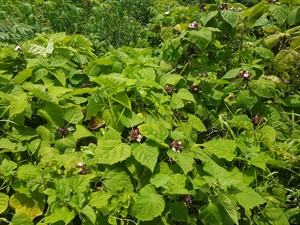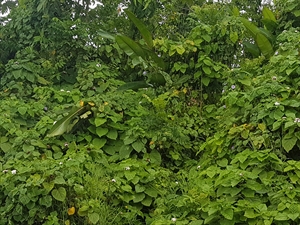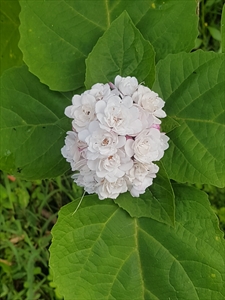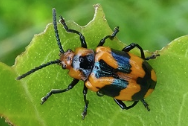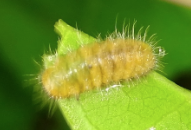Honolulu rose; it is also known as Spanish jasmine. CABI prefers the name Chinese glory.
Pacific Pests, Pathogens, Weeds & Pesticides - Online edition
Pacific Pests, Pathogens, Weeds & Pesticides
Honolulu rose (443)
Clerodendrum chinense. It was previously known as Clerodendrum philippinum, and Clerodendrum fragrans. It is a member of the Lamiaceae.
Asia, North, South and Central America, the Caribbean, Oceania. It is recorded from Australia, Cook Islands, Federated States of Micronesia, Fiji, French Polynesia, Niue, Papua New Guinea, and Samoa.
It is a native of southern China and northern Vietnam. Interestingly, it has been naturalised in South America for 150 years and is considered a minor weed. It is also a minor weed in the eastern Pacific (e.g., French Polynesia), and in Hawaii. By contrast, it is a serious weed in the southwest Pacific, i.e., American Samoa, Fiji, Niue, and Samoa.
An important invasive weed. It favours tropical and sub-tropical environments, rainfall of more than 1000 mm per year, full sunlight, and fertile soils (especially those of geologically-recent volcanic islands), but it can tolerate shade and will grow in disturbed places. Its invasiveness comes from an ability to rapidly establish due to formation of root suckers, leading to dense stand in pastures, plantations, along streams, at forest edges, outcompeting other species (Photos 1&2). Similarly, it forms dense thickets along roadsides and in town gardens (Photo 3). It is found from near sea level to an elevation of about 900 masl.
A perennial shrub up to 3 m tall. Stems and branches are four-sided with fine hairs. Leaves are large, 6-20 cm long, opposite, heart-shaped, with soft short hairs, wavy margins and sharp tips (Photo 4). The leaves have a disagreeable small when crushed. Flowers are 2-3 cm across, white to pink, double, sterile (without stamens or ovaries), in a dense cluster, 4-12 cm diameter, at the top of each stem (Photos 5&6). They are fragrant, especially in the evening, and attract butterflies. The flowers take turns to bloom, each lasting about 3 days.
Honolulu rose spreads by root suckers which extend far beneath the soil surface and, at intervals, produce new plants. Long distance spread occurs in the trade of ornamental plants.
Honolulu rose is only considered to be of economic importance in eastern Pacific countries, but not elsewhere. Surveys in the 1980s in Samoa showed the seriousness of the weed with invasions of pastures, plantations and roadsides. It was recorded in 7-23% of taro fields, spreading by root suckers and forming dense thickets. It was estimated that in open areas, clumps of bushes were expanding at the rate of 6-8 metre per year. In banana plantations, the weed covered 20-40% of the land and, in land that was left temporarily uncropped, the figure was 80%.
It is planted as an ornamental and used in bouquets. It is used in medicinally for several skin ailments.
BIOSECURITY
Risk of introduction and spread of Honolulu rose is high, because of its showy flowers make it appealing as an ornamental. Countries not yet infested should consider all likely pathways for entry, and apply quarantine measures accordingly. Special consideration should be given to the part played by the domestic and international trade in ornamental plants, as well as traditional medicines, in the spread of this invasive weed. It is available for purchase on the internet.
BIOLOGICAL CONTROL
Waterhouse (1993) suggests that Phyllocharis undulata (a chrysomelid beetle) from Southeast Asia has potential, but host specificity tests are needed (Photos 7-9). More work is needed on the taxonomy of the weed in the Pacific, too; trials in Thailand, for instance, found that Phyllocharis undulata only survived on Clerodendrum chinensis var. simplex - a plant different from that in northern Vietnam where the beetle was sourced. The rust, Aecidium clerodendri, from the Philippines may also have potential.
CULTURAL CONTROL
-
Physical & Mechanical
-
Hand weed or dig out the plants.
-
Use a knife to slash the plants; this will slow but not prevent growth.
-
Cultivate when soil is dry; but cultivation in moist soil is probably ineffective and may spread the weed.
-
CHEMCIAL CONTROL
In Fiji, glyphosate or metsulfuron-methyl. Other suggestions from the literature:
-
Foliar applications: picloram; triclopyr; 2,4-D; or metsulfuorn-methyl. There are products combining picloram + triclopyr; picloram + 2,4-D; and dicamba + 2,4-D.
-
Cut-stump applications of the same herbicides. (See Fact Sheet no. 442 for methods).
-
Soil applications: fluroxypyr.
For foliar applications, it is recommended that the plants are slashed and the new growth is then sprayed.
--------------------
Note, in the EU, approval to use glyphosate ends in December 2022; its use after that date is under discussion.
____________________
When using a pesticide, always wear protective clothing and follow the instructions on the product label, such as dosage, timing of application, and pre-harvest interval. Recommendations will vary with the crop and system of cultivation. Expert advice on the most appropriate herbicides to use should always be sought from local agricultural authorities.
AUTHORS Grahame Jackson & Aradhana Deesh
Information from Waterhouse DF (1993) Clerodendrum chinense (Osbeck) Mabberley. Biological control: Pacific prospects - Supplement 2. ACIAR Monograph No. 20. pp.72-93; and Pacific Island Ecosystems at Risk (2013) Clerodendrum chinense. (http://www.hear.org/pier/species/clerodendrum_chinense.htm); and CABI (2019) Clerodendrum chinense (Chinese glory bower). Invasive Species Compendium. (https://www.cabi.org/isc/datasheet/113371); and from Saengyot S, Napompeth B (2008) Biological control of Honolulu rose, Clerodendrum chinense (Osbeck) Mabberley (Lamiaceae), in Thailand, p.145-151. In: Academic Frontier Research Project (Phase II). Academic Frontier Research Center, Tokyo University of Agriculture. Tokyo, Japan. Photos 5-7 Banpot Napompeth, Kasetsart University, Bangkok, Thailand.
Produced with support from the Australian Centre for International Agricultural Research under project HORT/2016/185: Responding to emerging pest and disease threats to horticulture in the Pacific islands, implemented by the University of Queensland, in association with the Pacific Community and Koronivia Research Station, Ministry of Agriculture, Fiji.
